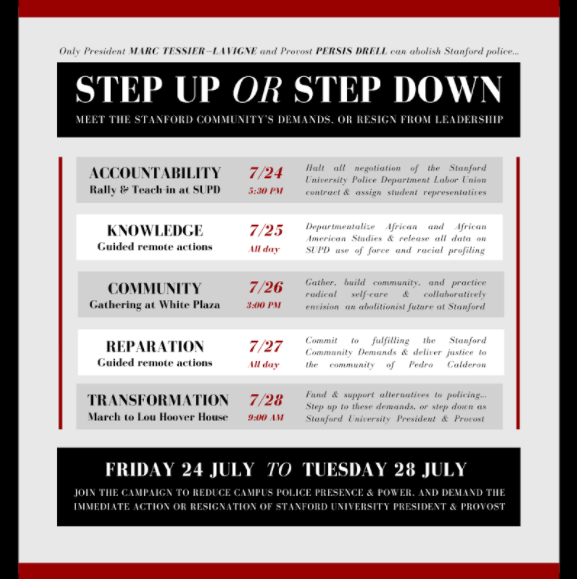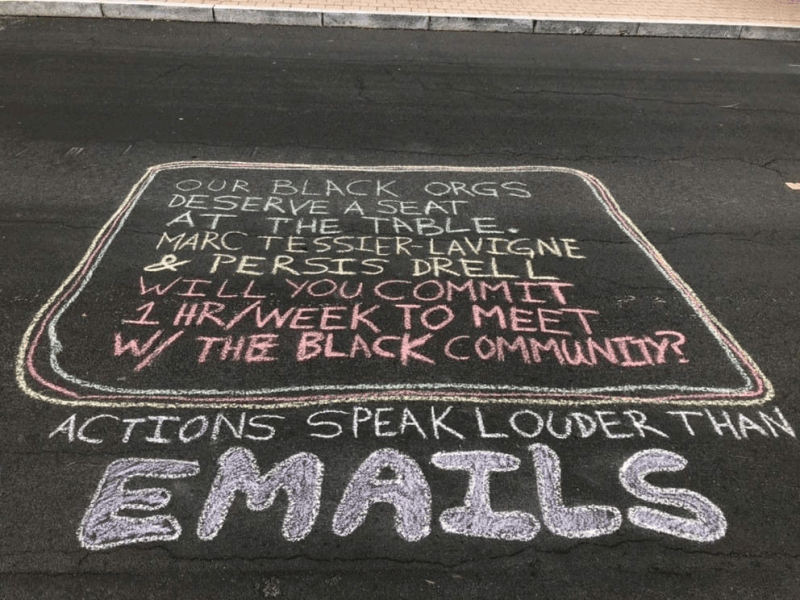This article is the second of a two-part series on Step Up or Step Down’s five days of action, lasting from Friday, July 24 to Tuesday, July 28. It takes a look back at the overarching goals of the campaign, whose demands for abolishing campus police presence are directed at University President Marc Tessier-Lavigne and Provost Persis Drell — step up to meet the demands, or step down from leadership.
Last week, students across campus participated in a week of action titled, Step Up or Step Down. Activists took part in five days of protests calling for the departmentalization of African and African-American Studies (AAAS) and the abolishment of the Stanford University Department of Public Safety (SUDPS), among several other demands.
If University President Marc Tesser-Lavigne and Provost Persis Drell do not “step up” to meet these demands, the movement calls for them to resign. Organized by a coalition of Stanford activists, each day highlighted key actions to take in support of the movement, both in-person and virtual.

Accountability
On July 24, Accountability Day, protestors focused on halting SUDPS contract renegotiations, which typically happen every five years.
The event included a teach-in featuring Missy Hart, a multiracial abolitionist and local artist who grew up nearby in Redwood City. At the event, Hart discussed their own experiences with police abuse of power and racial profiling after becoming a ward of the court at age 11, and “having that personal experience of growing up in the area and being criminalized and brutalized and being put in their gang database systems, just different ways that they are creating this narrative that we are these thugs over there that they just want to cleanse us out,” they said. After their release from state custody at age 18, they became the first in their family to earn a high school degree, followed by an Associates in Art degree.
“What really motivates me to go out and speak and just share the knowledge I have, both that I’ve learned and that I’ve experienced, and then just building solidarity,” Hart said.
Knowledge
On July 25, Knowledge Day, advocates fought for the departmentalization of AAAS.
“Doing so would direct funding towards the department and it would create a major for students who would want to pursue that,” Jessica Femenias ’23, an organizer of the event said. “It would also probably necessitate hiring more black academics.”
In the aftermath of the most recent Black Lives Matter protests, Tessier-Lavigne sent a letter to the Stanford Community outlining plans to advance racial justice on campus. He announced the cluster hire of 10 new faculty members who study the impact of race in America, the establishment of a Center for Racial Justice at Stanford Law School, and has pledged to support existing programs including the Martin Luther King, Jr. Research and Education Institute and African and African-American Studies.
However, some community members felt the statement and these efforts would not be sufficient, especially with regards to departmentalizing AAAS.
“As a director of African and African American Studies, and as a historian, I am disappointed that there isn’t more about developing and strengthening and building African American Studies at Stanford,” Allyson Hobbs said in an earlier interview with The Daily. Hobbs is the current AAAS director and an American History associate professor.
Community
On July 26, Community Day, demonstrations centered around self-care and envisioning an abolitionist future. Femenias emphasized the importance of community building.
“If we are serious about creating a campus that has made police obsolete that will necessitate…the sort of community where everyone knows that everyone else kind of has each other’s back,” she said.
She also explained that, in her opinion, the day was also an opportunity to “take a break because all of this is incredibly tiring especially for the people that these issues most directly affect.”
Reparation
On July 27, Reparation Day, activists called for police abolition and the payment of reparations to the family of Pedro Calderon, who was shot and killed at the base of the Stanford foothills in 2002. Stanford police deputy Jeff Bell and Palo Alto Police Officer Jessica Perryman both fired their gun once at Calderon. It was determined that Perryman shot the fatal bullet, but a grand jury cleared her of wrongdoing after completing an independent investigation.
At the time, Calderon’s aunt, Angelina Sepulveda of East Palo Alto, told the Palo Alto Weekly the family is “very unhappy” that the officer who shot Calderon was cleared of all charges.
“We still want to know what really happened,” she said. “I feel so sad.”
University spokesperson E.J. Miranda responded to the demands in an earlier statement to The Daily, noting that “the loss of any person’s life is cause for remorse” but that the “Stanford deputy’s actions did not result in Mr. Calderon’s death.”
Transformation
On July 28, Transformation Day and the final day of protest, protestors focused on their goal of creating a no-police campus, and marched from White Fountain Plaza to Tessier-Lavigne’s house to advocate for funding policing alternatives.
To address theft on a post-police campus, they suggested proactive environmental design solutions and a public fund for community members to replace stolen items. To address sexual assault and misconduct on campus, Femenias belives there ought to be “funding for people who are trained to address sexual assault.”
According to Miranda, SUDPS is “focusing on the elements of systemic injustice in our society, and we recognize there are aspects of policing that must change in order to foster an environment in which people can live without being subject to racism, discrimination, harassment or violence.”
In addition, the University has created a Community Board on Public Safety, which will “serve as a forum for hearing suggestions and concerns from our community on public safety issues, and for making recommendations to university leadership,” Miranda wrote.
Student perspectives on University response
“For the last several years varying black student organizations, especially graduate organizations, have been advocating for a set of improvements. Their demands have not been met, they haven’t been taken seriously,” Femenias said.
“Mark and Persis function as barriers for achieving [our] ambitions,” she added. “In our minds, the function of a university is to be maximally hospitable to its underrepresented students and if [Mark and Persis] are barriers to that then we think they should step down.”
The Black Graduate Students Association (BGSA) was also not satisfied with Tessier-Lavigne’s June 30 proposal, writing it “falls short of properly addressing anti-Blackness,” in a Daily op-ed.
4th year Ph.D. student Nina Horowitz was pleased by student turnout.
“I have seen a ton of support on social media and it was good to see so many people at the teach-in [on Monday],” she said.
However, several event participants felt more professors and staff should support the event. 5th year medical student Natasha Abadilla ’14 pointed out that unlike most undergraduate students many staff members are still on campus and could have attended.
Though Abadilla acknowledges that “faculty and staff are really scared of showing up at these events…it goes against the people who hire them and write their paychecks,” she still feels there ought to be more support from professors and staff members in positions of privilege.
Femenias agrees. “Professors have the ability to pressure [the president and provost] more than students can. They have more leverage,” she said.
Activists are still concerned that the demands may not be implemented.
“Stanford is a difficult entity to force change upon,” Horowitz said. “But I do really hope that we will be able to successfully push for departmentalization of AAAS, at least. It would be amazing to alter the police contract renegotiation as well…but unfortunately I’m not sure if that will actually happen.”
However, even if the results don’t come right away, Femenias says there will be “more fighting, more marching, more annoying them.” And if people continue to protest, Hart believes that the goals of the movement will be accomplished.
“If we continue to put this pressure [on them] and we continue to keep with the momentum and keep doing it, I think it will be successful, but they’re banking on it just silently going away,” they said.
“In general all of us have a deep obligation to care for one another,” Femenias said. “Whatever it takes to make that care actionable is an obligation that each of us have, even when it’s inconvenient. So if you have to do something that’s inconvenient as calling for the resignation of the president of your university, it’s worth it.”
Contact Io Gilman at ioyehgilman ‘at’ gmail.com and Rae Wymer at raewymer ‘at’ gmail.com.
